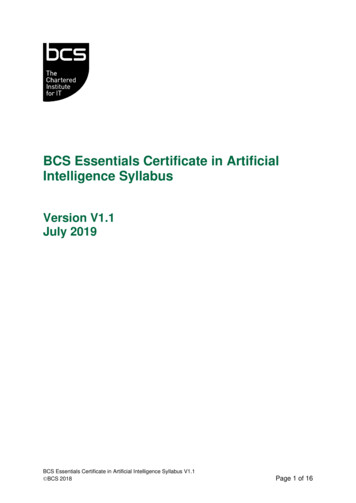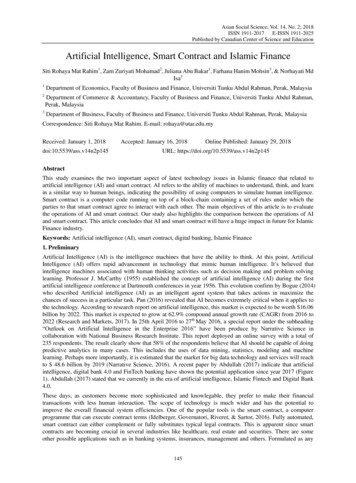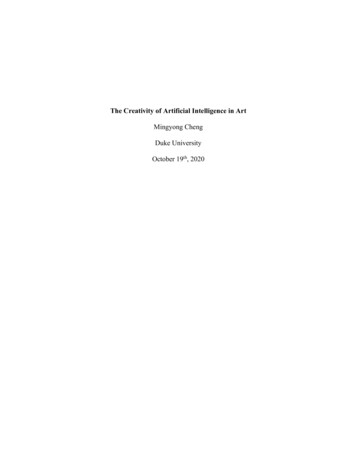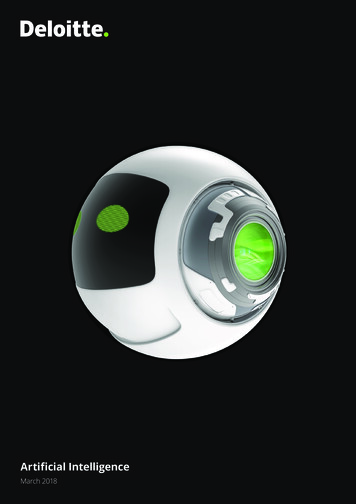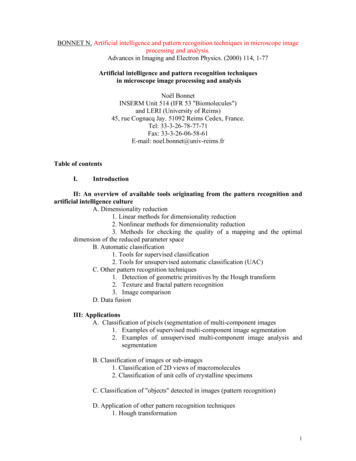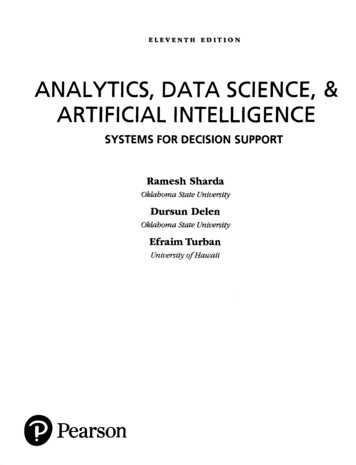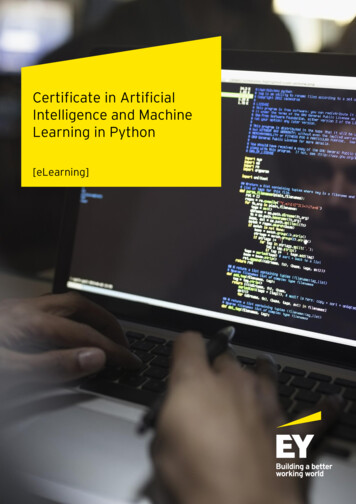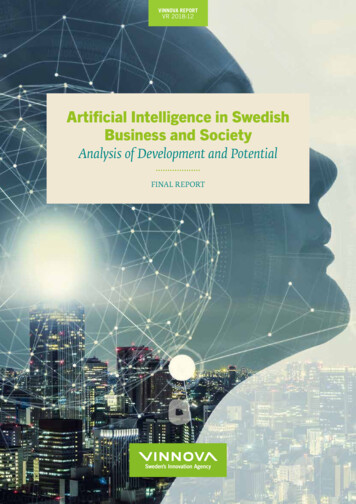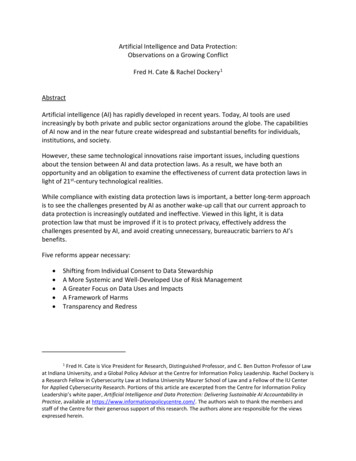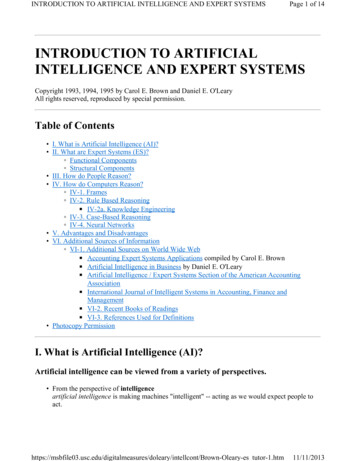
Transcription
INTRODUCTION TO ARTIFICIAL INTELLIGENCE AND EXPERT SYSTEMSPage 1 of 14INTRODUCTION TO ARTIFICIALINTELLIGENCE AND EXPERT SYSTEMSCopyright 1993, 1994, 1995 by Carol E. Brown and Daniel E. O'LearyAll rights reserved, reproduced by special permission.Table of Contents I. What is Artificial Intelligence (AI)? II. What are Expert Systems (ES)? Functional Components Structural Components III. How do People Reason? IV. How do Computers Reason? IV-1. Frames IV-2. Rule Based Reasoning IV-2a. Knowledge Engineering IV-3. Case-Based Reasoning IV-4. Neural Networks V. Advantages and Disadvantages VI. Additional Sources of Information VI-1. Additional Sources on World Wide Web Accounting Expert Systems Applications compiled by Carol E. Brown Artificial Intelligence in Business by Daniel E. O'Leary Artificial Intelligence / Expert Systems Section of the American AccountingAssociation International Journal of Intelligent Systems in Accounting, Finance andManagement VI-2. Recent Books of Readings VI-3. References Used for Definitions Photocopy PermissionI. What is Artificial Intelligence (AI)?Artificial intelligence can be viewed from a variety of perspectives. From the perspective of intelligenceartificial intelligence is making machines "intelligent" -- acting as we would expect people leary/intellcont/Brown-Oleary-es tutor-1.htm11/11/2013
INTRODUCTION TO ARTIFICIAL INTELLIGENCE AND EXPERT SYSTEMSPage 2 of 14 The inability to distinguish computer responses from human responses is called theTuring test. Intelligence requires knowledge Expert problem solving - restricting domain to allow including significant relevantknowledge From a research perspective"artificial intelligence is the study of how to make computers do things which, at the moment,people do better" [Rich and Knight, 1991, p.3]. AI began in the early 1960s -- the first attempts were game playing (checkers), theoremproving (a few simple theorems) and general problem solving (only very simple tasks) General problem solving was much more difficult than originally anticipated.Researchers were unable to tackle problems routinely handled by human experts. The name "artificial intelligence" came from the roots of the area of study.AI researchers are active in a variety of domains.Domains include: Formal Tasks (mathematics, games), Mundane tasks (perception, robotics, natural language, common sense reasoning) Expert tasks (financial analysis, medical diagnostics, engineering, scientificanalysis, and other areas) From a business perspective AI is a set of very powerful tools, and methodologies for usingthose tools to solve business problems. From a programming perspective, AI includes the study of symbolic programming, problemsolving, and search. Typically AI programs focus on symbols rather than numeric processing. Problem solving - achieve goals. Search - seldom access a solution directly. Search may include a variety of techniques. AI programming languages include: LISP, developed in the 1950s, is the early programming language stronglyassociated with AI. LISP is a functional programming language with proceduralextensions. LISP (LISt Processor) was specifically designed for processingheterogeneous lists -- typically a list of symbols. Features of LISP that made itattractive to AI researchers included run- time type checking, higher eary/intellcont/Brown-Oleary-es tutor-1.htm11/11/2013
INTRODUCTION TO ARTIFICIAL INTELLIGENCE AND EXPERT SYSTEMSPage 3 of 14functions (functions that have other functions as parameters), automatic memorymanagement (garbage collection) and an interactive environment. The second language strongly associated with AI is PROLOG. PROLOG wasdeveloped in the 1970s. PROLOG is based on first order logic. PROLOG isdeclarative in nature and has facilities for explicitly limiting the search space. Object-oriented languages are a class of languages more recently used for AIprogramming. Important features of object-oriented languages include: concepts of objects and messages objects bundle data and methods for manipulating the data sender specifies what is to be done receiver decides how to do it inheritance (object hierarchy where objects inherit the attributes of the moregeneral class of objects)Examples of object-oriented languages are Smalltalk, Objective C, C . Objectoriented extensions to LISP (CLOS - Common LISP Object System) and PROLOG(L&O - Logic & Objects) are also used.II. What are Expert Systems (ES)?Definitions of expert systems vary. Some definitions are based on function. Some definitions arebased on structure. Some definitions have both functional and structural components. Many earlydefinitions assume rule-based reasoning.Functional ComponentsWhat the system does (rather than how)". a computer program that behaves like a human expert in some useful ways." [Winston &Prendergast, 1984, p.6] Problem area ". solve problems efficiently and effectively in a narrow problem area." [Waterman,1986, p.xvii] ". typically, pertains to problems that can be symbolically represented" [Liebowitz,1988, p.3] Problem difficulty ". apply expert knowledge to difficult real world problems" [Waterman, 1986, p.18] ". solve problems that are difficult enough to require significant human expertise fortheir solution" [Edward Feigenbaum in Harmon & King, 1985, p.5] ". address problems normally thought to require human specialists for theirsolution" [Michaelsen et al, 1985, p. eary/intellcont/Brown-Oleary-es tutor-1.htm11/11/2013
INTRODUCTION TO ARTIFICIAL INTELLIGENCE AND EXPERT SYSTEMSPage 4 of 14 Performance requirement "the ability to perform at the level of an expert ." [Liebowitz, 1988, p.3] ". programs that mimic the advice-giving capabilities of human experts." [Brule, 1986,p.6] ". matches a competent level of human expertise in a particular field." [Bishop, 1986,p.38] ". can offer intelligent advice or make an intelligent decision about a processingfunction." [British Computer Society's Specialist Group in Forsyth, 1984, pp.9-10] ". allows a user to access this expertise in a way similar to that in which he mightconsult a human expert, with a similar result." [Edwards and Connell, 1989, p.3] Explain reasoning ". the capability of the system, on demand, to justify its own line of reasoning in amanner directly intelligible to the enquirer." [British Computer Society's Specialist Groupin Forsyth, 1984, p.9-10] "incorporation of explanation processes ." [Liebowitz, 1988, p.3]Structural ComponentsHow the system functions Use AI techniques ". using the programming techniques of artificial intelligence, especially thosetechniques developed for problem solving" [Dictionary of Computing, 1986, p.140] Knowledge component ". the embodiment within a computer of a knowledge-based component, from an expertskill ." [British Computer Society's Specialist Group in Forsyth, 1984, pp.9-10] "a computer based system in which representations of expertise are stored ." [Edwardsand Connell, 1989, p.3] "The knowledge of an expert system consists of facts and heuristics. The 'facts' constitutea body of information that is widely shared, publicly available, and generally agreed uponby experts in the field." [Edward Feigenbaum in Harmon & King, 1985, p.5] "Expert systems are sophisticated computer programs that manipulate knowledge to solveproblems" [Waterman, 1986, p.xvii] Separate knowledge and oleary/intellcont/Brown-Oleary-es tutor-1.htm11/11/2013
INTRODUCTION TO ARTIFICIAL INTELLIGENCE AND EXPERT SYSTEMSPage 5 of 14 ". make domain knowledge explicit and separate from the rest of thesystem" [Waterman, 1986, p.18]. Use inference procedures - heuristics - uncertainty ". an intelligent computer program that uses knowledge and inferenceprocedures" [Edward Feigenbaum in Harmon & King, 1985, p.5] "The style adopted to attain these characteristics is rule-based programming." [BritishComputer Society's Specialist Group in Forsyth, 1984, p.9-10] "Exhibit intelligent behavior by skillful application of heuristics." [Waterman, 1986,p.18]. "The 'heuristics' are mostly private, little rules of good judgment (rules of plausiblereasoning, rules of good guessing) that characterize expert-level decision making in thefield." [Edward Feigenbaum in Harmon & King, 1985, p.5] "incorporation of . ways of handling uncertainty."[Liebowitz, 1988, p.3] Model human expert ". can be thought of as a model of the expertise of the best practitioners of thefield." [Edward Feigenbaum in Harmon & King, 1985, p.5] ". representation of domain-specific knowledge in the manner in which the expertthinks" [Liebowitz, 1988, p.3] ". involving the use of appropriate information acquired previously from humanexperts." [Dictionary of Computing, 1986, p.140]III. How do People Reason? They create categories Cash is a Current Asset A Current Asset is an Asset They use specific rules, a priori rules E.g., tax law . . . so much for each deduction Rules can be cascaded "If A then B" . . . "If B then C" A--- B--- /intellcont/Brown-Oleary-es tutor-1.htm11/11/2013
INTRODUCTION TO ARTIFICIAL INTELLIGENCE AND EXPERT SYSTEMSPage 6 of 14 They Use Heuristics --- "rules of thumb" Heuristics can be captured using rules "If the meal includes red meat Then choose red wine" Heuristics represent conventional wisdom They use past experience --- "cases" Particularly evident in precedence-based reasoninge.g. law or choice of accounting principles Similarity of current case to previous cases provides basis for action choice Store cases using key attributescars may be characterized by: year of car; make of car; speed of car etc. What makes good argumentation also makes good reasoning They use "Expectations" "You are not yourself today"If we differ from expectations then it is recognized "Patterns of behavior"IV. How do Computers Reason?Computer models are based on our models of human reasoning Framesframe attributes called "slots"each frame is a node in one or more "isa" hierarchies They use rules A--- B--- CAuditing, tax . . .Set of rules is called knowledge base or rule base They use casesTax reasoning and tax casesSet of cases is called a case base They use pattern recognition/expectationsCredit card systemData base security leary/intellcont/Brown-Oleary-es tutor-1.htm11/11/2013
INTRODUCTION TO ARTIFICIAL INTELLIGENCE AND EXPERT SYSTEMSPage 7 of 14IV-1. Frames a network of nodes and relations in some ways very similar to a traditional database and in other ways very different attributes called "slots" value can be stated explicitly a method for determining the value rather than the value itself each frame is a node in one or more "isa" hierarchies higher levels general concepts - lower levels specific unspecified value can be inherited from the more general node concept: prototypical representation with defaults that may be overridden ExampleTo describe a thing growing in my back yard: an elm is a deciduous tree, a deciduous treeis a tree, a tree is a plant, a plant is a living organism.IV-2. Rule Based ReasoningCurrently, the most common form of expert systemStructure of a Rule-based Expert System User Interface Friendly Maybe "Intelligent" Knowledge of how to present information Knowledge of user preferences.possibly accumulate with use Databases Contains some of the data of interest to the system May be connected to on-line company or public database Human user may be considered a database Inference leary/intellcont/Brown-Oleary-es tutor-1.htm11/11/2013
INTRODUCTION TO ARTIFICIAL INTELLIGENCE AND EXPERT SYSTEMSPage 8 of 14 general problem-solving knowledge or methods interpreter analyzes and processes the rules scheduler determines which rule to look at next the search portion of a rule-based system takes advantage of heuristic information otherwise, the time to solve a problem could become prohibitively long this problem is called the combinatorial explosion expert-system shell provides customizable inference engine Knowledge Base (rule base) contains much of the problem solving knowledge Rules are of the form IF condition THEN action condition portion of the rule is usually a fact - (If some particular fact is in thedatabase then perform this action) action portion of the rule can include actions that affect the outside world (print a message on the terminal) test another rule (check rule no. 58 next) add a new fact to the database (If it is raining then roads are wet). Rules can be specific, a priori rules (e.g., tax law . . . so much for each exemption) represent laws and codified rules Rules can be heuristics (e.g. If the meal includes red meat then choose red wine). "rulesof thumb" - represent conventional wisdom. Rules can be chained together (e.g. "If A then B" "If B then C" since A--- B--- C so "IfA then C").(If it is raining then roads are wet. If roads are wet then roads are slick.) Certainty factors represent the confidence one has that a fact is true or a rule is validIV-2a. Knowledge Engineeringthe discipline of building expert oleary/intellcont/Brown-Oleary-es tutor-1.htm11/11/2013
INTRODUCTION TO ARTIFICIAL INTELLIGENCE AND EXPERT SYSTEMSPage 9 of 14The Role of the Knowledge Engineer Knowledge acquisition the process of acquiring the knowledge from human experts or other sources(e.g. books, manuals) can involve developing knowledge to solve the problem knowledge elicitation coaxing information out of human experts Knowledge representation Method used to encode the knowledge for use by the expert system Common knowledge representation methods include rules, frames, and cases. Putting the knowledge into rules or cases or patterns is the knowledge representationprocessIV-3. Case-Based ReasoningThe Case-based Reasoning Process Uses past experiences Based on the premise that human beings use analogical reasoning or experiential reasoning tolearn and solve complex problems Particularly evident in precedence-based reasoning(e.g. tax law or choice of accounting principles) Useful when little evidence is available or information is incomplete Cases consist of information about the situation the solution the results of using that solution key attributes that can be used for quickly searching for similar patterns of attributes Elements in a case-based reasoning system the case base - set of cases the index library - used to efficiently search and quickly retrieve cases that are mostappropriate or similar to the current problem similarity metrics - used to measure how similar the current problem is to the past casesselected by searching the index oleary/intellcont/Brown-Oleary-es tutor-1.htm11/11/2013
INTRODUCTION TO ARTIFICIAL INTELLIGENCE AND EXPERT SYSTEMSPage 10 of 14 the adaption module - creates a solution for the current problem by either modifying thesolution (structural adaptation) or creating a new solution using the same process as wasused in the similar past case (derivational adaptation). Learning If no reasonably appropriate prior case is found then the current case and its humancreated solution can be added to the case base thus allowing the system to learn.IV-4. Neural Networks(artificial neural networks and connectionist models) Based on pattern recognition - used for credit assessment and fraud detection A set of interconnected relatively simple mathematical processing elements Looks for patterns in a set of examples and learns from those examples by adjusting the weightsof the connections to produce output patterns Input to output pattern associations are used to classify a new set of examples Able to recognize patterns even when the data is noisy, ambiguous, distorted, or has a lot ofvariation Neural network construction and training the architecture used (e.g. feed-forward) how the neurons are organized (e.g. an input layer with five neurons, two hidden layerswith three neurons each, and an output layer with two neurons.) the state function used (e.g. summation function) the transfer functions used (e.g. sigmoid squashing function) the training algorithm used (e.g. back-propagation) Architecture How the processing elements are connected Commonly used architectures: feed-forwardFeed-Forward Neural Network Structure Boltzmann Layers (also called levels, fields or slabs) Organized into a series of layers input layer one or more hidden layers output layer Some consider the number of layers to be part of architecture Others consider the number of layers and nodes per layer to be attributes of the networkrather than part of the res/doleary/intellcont/Brown-Oleary-es tutor-1.htm11/11/2013
INTRODUCTION TO ARTIFICIAL INTELLIGENCE AND EXPERT SYSTEMSPage 11 of 14 Neurons - the processing elementsThe vocabulary in this area is not completely consistent and different authors tend to use one ofa small set of terms for a particular concept.Structure of a Neuron consists of a set of weighted input connections a bias input a state function a nonlinear transfer function an output Input connections have an input value that is either received from the previous neuron orin the case of the input layer from the outside Bias is not connected to the other neurons in the network and is assumed to have an inputvalue of 1 for the summation function Weights A real number representing the strength or importance of an input connection to aneuron Each neuron input, including the bias, has an associated weight State function The most common form is a simple summation function The output of the state function becomes the input for the transfer function Transfer function A nonlinear mathematical function used to convert data to a specific scale Two basic types of transfer functions: continuous and discrete Commonly used continuous functions used are Ramp, Sigmoid, Arc Tangent andHyperbolic Tangent Continuous functions sometimes called squashing functions Commonly used discrete functions are Step and Threshold Discrete transfer function sometimes called activation function Training The process of using examples to develop a neural network that associates the inputpattern with the correct answer A set of examples (training set) with known outputs (targets) is repeatedly fed into thenetwork to "train" the network This training process continues until the difference between the input and output patternsfor the training set reaches an acceptable value Several algorithms used for training networksmost common is back-propagation Back-propagation is done is two passes First the inputs are sent forward through the network to produce an output Then the difference between the actual and desired outputs produces error signalsthat are sent "backwards" through the network to modify the weights of the oleary/intellcont/Brown-Oleary-es tutor-1.htm11/11/2013
INTRODUCTION TO ARTIFICIAL INTELLIGENCE AND EXPERT SYSTEMSPage 12 of 14V. Advantages and DisadvantagesV-1. Advantages of Expert Systems Permanence - Expert systems do not forget, but human experts may Reproducibility - Many copies of an expert system can be made, but training new humanexperts is time-consuming and expensive If there is a maze of rules (e.g. tax and auditing), then the expert system can "unravel" the maze Efficiency - can increase throughput and decrease personnel costs Although expert systems are expensive to build and maintain, they are inexpensive tooperate Development and maintenance costs can be spread over many users The overall cost can be quite reasonable when compared to expensive and scarce humanexperts Cost savings:Wages - (elimination of a room full of clerks)Other costs - (minimize loan loss) Consistency - With expert systems similar transactions handled in the same way. The systemwill make comparable recommendations for like situations.Humans are influenced by recency effects (most recent information having a disproportionate impact on judgment) primacy effects (early information dominates the judgment). Documentation - An expert system can provide permanent documentation of the decisionprocess Completeness - An expert system can review all the transactions, a human expert can onlyreview a sample Timeliness - Fraud and/or errors can be prevented. Information is available sooner for decisionmaking Breadth - The knowledge of multiple human experts can be combined to give a system morebreadth that a single person is likely to achieve Reduce risk of doing business Consistency of decision making Documentation Achieve Expertise Entry barriers - Expert systems can help a firm create entry barriers for potential competitors Differentiation - In some cases, an expert system can differentiate a product or can be relatedto the focus of the firm leary/intellcont/Brown-Oleary-es tutor-1.htm11/11/2013
INTRODUCTION TO ARTIFICIAL INTELLIGENCE AND EXPERT SYSTEMSPage 13 of 14 Computer programs are best in those situations where there is a structure that is noted aspreviously existing or can be elicitedV-2. Disadvantages of Rule-Based Expert Systems Common sense - In addition to a great deal of technical knowledge, human experts havecommon sense. It is not yet known how to give expert systems common sense. Creativity - Human experts can respond creatively to unusual situations, expert systemscannot. Learning - Human experts automatically adapt to changing environments; expert systems mustbe explicitly updated. Case-based reasoning and neural networks are methods that canincorporate learning. Sensory Experience - Human experts have available to them a wide range of sensoryexperience; expert systems are currently dependent on symbolic input. Degradation - Expert systems are not good at recognizing when no answer exists or when theproblem is outside their area of expertise.VI. Additional Sources of InformationVI-1. Additional Sources on World Wide Web Accounting Expert Systems Applications compiled by Carol E. BrownArtificial Intelligence in Business by Daniel E. O'LearyArtificial Intelligence / Expert Systems Section of the American Accounting AssociationInternational Journal of Intelligent Systems in Accounting, Finance and ManagementVI-2. Recent Books of Readings Expert Systems in FinanceDaniel E. O'Leary and Paul R. Watkins (Editors), 1992, Amsterdam: NorthHolland Expert Systems in Business and Finance: Issues and ApplicationsPaul R. Watkins and Lance B. Elliot (Editors), 1993, Chichester: John Wiley andSons. Artificial Intelligence in Accounting and Auditing: Using Expert Systems, Volume IIMiklos A. Vasarhelyi and B.N. Srinidhi (Editors), 1993, Princeton, NJ: MarkusWiener Publishing, eary/intellcont/Brown-Oleary-es tutor-1.htm11/11/2013
INTRODUCTION TO ARTIFICIAL INTELLIGENCE AND EXPERT SYSTEMSPage 14 of 14VI-3. References Used for Definitions Anonymous. Dictionary of Computing, 1986, New York: Oxford University Press. Bishop, Peter. Fifth Generation Computers Concepts, Implementations & Uses, 1986,Chichester, England: Ellis Horwood Ltd. Brule, James F. Artificial Intelligence: Theory, Logic and Application, 1986, Blue RidgeSummit, PA: TAB Books. Edwards, Alex and Connell, N.A.D. Expert Systems in Accounting, 1989, Herfordshire, UK:Prentice Hall International (UK) Ltd. Forsyth, Richard, Expert Systems: Principles and Case Studies, 1984, London: Chapman andHall Computing. Harmon, Paul and King, David. Expert Systems: Artificial Intelligence in Business. 1985, NewYork: Wiley. Liebowitz, Jay, Introduction to Expert Systems, 1988, Santa Cruz, CA: Mitchell Publishing,Inc. Michaelsen, Robert H.; Michie, Donald and Boulanger, Albert. "The Technology of ExpertSystems" Byte; April 1985; 10(4): pp. 303-312. Rich, Elaine and Knight, Kevin. Artificial Intelligence Second Edition. 1991, New York:McGraw-Hill. Waterman, Donald A. A Guide to Expert Systems, 1986, Reading, MA: Addison-Wesley. Winston, Patrick H. and Prendergast, Karen A. (Editors). The AI Business: Commercial Use ofArtificial Intelligence, 1984, Cambridge, MA: The MIT Press.Introduction to Artificial Intelligence and Expert SystemsCopyright 1993, 1994, 1995 by Carol E. Brown, Oregon State University, (brownc@bus.orst.edu)and Dan E. O'Leary, University of Southern California, (Oleary@rcf.usc.edu)All rights reserved, Reproduced by special permission. Photocopy PermissionPage last updated December 17, ary/intellcont/Brown-Oleary-es tutor-1.htm11/11/2013
Accounting Expert Systems Applications compiled by Carol E. Brown Artificial Intelligence in Business by Daniel E. O'Leary Artificial Intelligence / Expert Systems Section of the American Accounting Association International Journal of Intelligent Systems in Accounting, Finance and Management VI-2. Recent Books of Readings VI-3.
